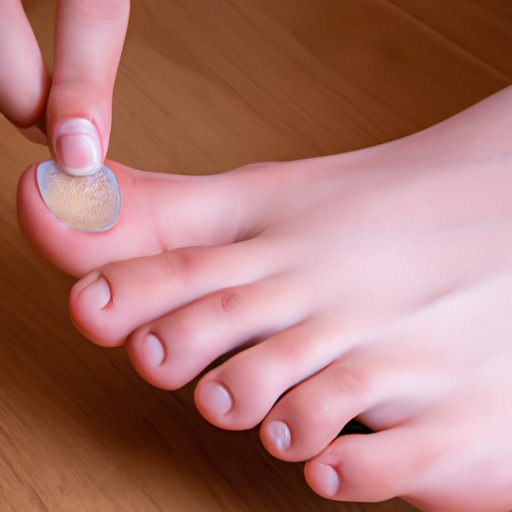
Introduction
If you’ve ever experienced a painful growth on your toe that feels like walking on a pebble, you know just how annoying and uncomfortable corns on toes can be. Corns are a common foot condition that typically develop on the bony areas of your foot or toes due to pressure or friction. In this article, we’ll explore home remedies, different types of corns, the importance of footwear, over-the-counter treatments, and when to seek professional help.
Home Remedies for Getting Rid of Corn on Toe
Before seeking professional help, many people prefer to try home remedies to see if they can get relief from their corns. Below are a few of the most commonly recommended home remedies:
Soaking Your Feet in Warm Water
One of the easiest and most effective ways to reduce pain and soothe the skin around a corn is by soaking your feet in warm water. This can help soften the skin and make it easier to remove the corn. Simply fill a basin or tub with warm water and add Epsom salt or vinegar to the water for extra benefits. Soak for 15-20 minutes, then pat your feet dry with a towel.
Using a Pumice Stone to Exfoliate
After soaking your feet, use a pumice stone to gently scrub away the dead skin around the corn. Be careful not to scrub too hard or remove too much skin at once, as this can lead to bleeding or infection. This method should be used in conjunction with proper footwear and other preventative measures to avoid future corns from developing.
Applying Castor Oil to the Affected Area
Castor oil has been shown to improve the appearance of corns and soften the rough, dry skin that can cause them. Simply apply a small amount of castor oil to the affected area and massage it in for a few minutes. Repeat this process twice daily until the corn has healed or disappeared.
Examining the Different Types of Corns on Toes
Not all corns are created equal, and there are three distinct types of corns that can develop:
Hard Corns
These are the most common type of corn and tend to develop on the tops and tips of toes or in areas where shoes rub against the skin. They typically look like a callus and feel like a hard, raised bump or cone. Hard corns can be quite painful and may require professional treatment if they continue to grow.
Soft Corns
Soft corns usually develop between the toes, where the skin is moist, warm, and rubbing against other skin surfaces. They are softer to the touch than hard corns and may appear white or gray. They can also be painful and require treatment to relieve discomfort and prevent recurrence in the future.
Seed Corns
Seed corns are the least common type of corn, but they can be just as uncomfortable and difficult to manage than the others. They typically form in clusters on the soles of the feet and feel like tiny, hard bumps that can be quite painful to walk on. They are often caused by sweating and poor ventilation of the feet and can be treated with medicated creams and regular exfoliation.
The Importance of Footwear in Preventing Corns
One of the most effective ways to prevent corns on toes is by wearing comfortable, supportive shoes that fit well. Shoes that are too tight or too loose can cause friction and pressure that lead to corns. Below are a few tips for choosing proper footwear:
- Choose shoes made from breathable, flexible materials to reduce friction and encourage air flow.
- Make sure there is enough room for your toes to wiggle and move comfortably.
- Use shoe inserts or orthotics to provide additional support and cushioning for your feet.
- Avoid wearing high heels or shoes with narrow, pointed toes for extended periods of time as they can push the toes together and cause corns to form.
How to Use Over-the-Counter Treatments for Corns
If home remedies and preventative measures don’t work, there are several over-the-counter treatments available that can help get rid of corns. Below are a few of the most effective treatments:
Medicated Pads
Medicated pads are typically made with salicylic acid or other active ingredients that help dissolve the corn. Simply apply the pad to the affected area and leave it on for a few hours. Be careful not to apply too much pressure to avoid tearing or breaking the skin.
Salicylic Acid
Salicylic acid is a common ingredient found in many over-the-counter corn treatments. It works by softening the skin and helping to break down the tough, dead skin cells that make up the corn. Apply the medication according to the instructions on the packaging and be patient, as it may take several weeks for the corn to disappear completely.
When to Seek Professional Help for Corns on Toes
While most corns can be treated at home or with over-the-counter medications, some may require professional care. Below are a few signs that you may need to make an appointment with a podiatrist:
- The corn is causing significant pain or discomfort that prevents you from walking normally.
- The corn is bleeding, oozing, or shows signs of infection.
- You have diabetes or other conditions that affect blood flow or the immune system.
- You have tried home remedies and over-the-counter treatments without relief.
To find a trustworthy podiatrist in your area, ask for referrals from your primary care physician or friends and family.
Conclusion
Corns on toes can be painful, annoying, and frustrating to deal with, but there are many ways to get relief. By trying home remedies, selecting proper footwear, and using over-the-counter treatments safely and effectively, you can keep your feet healthy and pain-free. If your corns persist or worsen despite your best efforts, don’t hesitate to seek professional help and get the treatment you need to get back on your feet.





